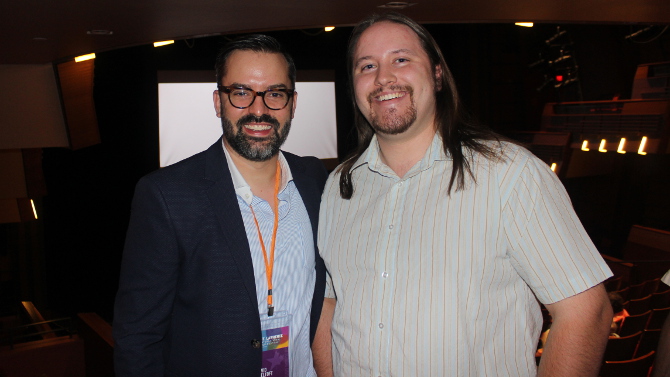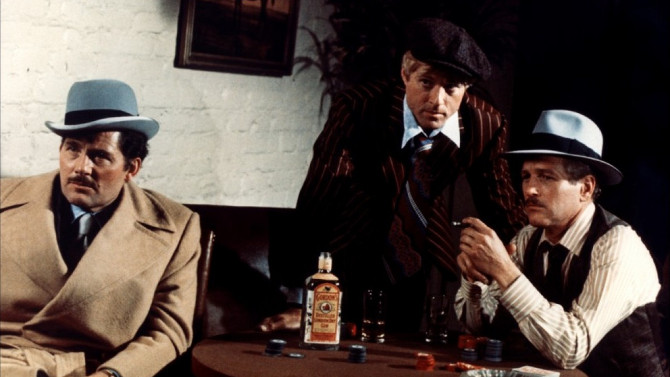Whether you’ve seen The Sting or not, it is nearly impossible not to recognize its main theme, titled “The Entertainer”. A feel good, catchy, ragtime tune that is heard on and off from very beginning to utter end, it is Marvin Hamlisch’s reworking of the 1902 song by Scott Joplin that adds an auditory flair to the piece.
It is this classic cinematic work that screenwriter David Ebeltoft, scribe of the Tribeca Audience Award Winner Here Alone, highlights as being his favourite. An up and coming writer in the business, his union with director Rod Blackhurst and producer Noah Lang (who was featured in last week’s Star Pick) seems like it is going to be a fruitful one, as the film making team have already announced two more features, You Were Once Called Queen City and North, following their first united effort – which has just been released and is doing very well in both theatres and online.
I interviewed the screenwriter following a special screening of his film, Here Alone, at the St. Lawrence International Film Festival gala (on September 3rd, 2016) in Potsdam, New York. Taking us inside the creative process of writing an award winning script, the screenwriter talked about his intimate, multi-faceted zombie tale. Also delving into the time he spent on the short film Night Swim, we discussed the struggles and benefits of working within the much tighter parameters of making a movie that is only a few minutes long. For any aspiring screenwriters, Ebeltoft also adds his top two tips for those starting out in the field. As we began to discuss The Sting toward the end of the interview, he immediately highlighted the perfect pairing of Paul Newman and Robert Redford. Also speaking to the groundbreaking aspects of the film, which is part of what has become known as the New Hollywood Era (a time of creative change found in the late 1960s and into the 1970s as the studio system evolved once again), Ebeltoft spoke of its highly entertaining nature, its ability to bring people on a journey of ups and downs, as well as the proverbial gut punch that hits the audience hard as the film heads to its epic conclusion (something the screenwriter has tried to use in each one of his own stories). Make sure to check out the interview below to hear all of Ebeltoft’s thoughts on The Sting, as well as all of the other topics mentioned above.
Set in depression era Chicago (specifically 1936), The Sting reunites the dream team of Newman and Redford (for the second and last time), along with director George Roy Hill, four years after the huge success they had with the 1969 motion picture Butch Cassidy and the Sundance Kid. Redford plays a low level grifter named Johnny Hooker, a streetwise hoodlum who pulls fast robberies with sneaky tricks and quick hands. His partner is the aged Luther Coleman (Robert Earl Jones), who, after their most recent take, has decided to hang up his boots and retire.
Suggesting that Hooker (who is also a degenerate gambler) should look up the big time con man Henry Gondorff (Paul Newman), the young gun seems uninterested in tracking the gent down – though he finally does so after an unexpected event forces him out of his indecision. He turns to Gondorff, looking for aid with his next target, Doyle Lonnegan (a delightful turn from Robert Shaw) – a man who has gotten on the wrong side of Hooker. Together, the pair form a team for the task.
Lonnegan, with his thick Irish brogue and ominous gimp (something Shaw worked into the role after injuring his knee just prior to production), is the type of man you wouldn’t want to cross – he’s clever, cunning and connected; a big time shark in the criminal underworld with a semblance of high class respectability, always surrounded by his thuggish bodyguards. One of the duo’s compatriots, J.J. Singleton (Ray Walston), perhaps explains the predicament best: “I don’t know what to do with this guy, Henry. He’s an Irishman who doesn’t drink, doesn’t smoke, and doesn’t chase dames. He’s a Grand Knight in the Knights of Colombus, and he only goes out to play faro. Sometimes plays 15 or 20 hours at a time, just him against the house.” Lonnegan’s one vice is high stakes poker – a game in which he has learned to tip the odds in his favour by devious trickery. Yet, this dangerous man is exactly who they want to swindle.
As you can imagine, things won’t be simple, especially since a crooked cop, Snyder (Charles Durning), is always breathing down Hooker’s neck – as the crook cheated the copper during one of his shakedowns, providing him with counterfeit cash instead of the real deal. There is also a mysterious individual who is never shown – we just see the ominous dark gloves of someone who is surveilling one of our leads. It highlights the dangerous game they are playing; a world in which every step taken could bring with it a new danger, or perhaps a trusted face that holds malice behind kind or lonely eyes.
Putting their minds together, the gang orchestrates the complex plan. Starting with a high stakes poker match on a train, Gondorff takes on the role of an obnoxious drunk who gets under the skin of the stately Lonnegan – continuously insulting him by getting his name wrong. Planning on cheating the cheat, it is this swindle that is just the first falling domino – a highly entertaining scene to say the least. Will the con men be able to avoid the shark infested waters, dodging the danger that circles around them in order to pull off the complicated heist? Or will dissension amongst the team cause them to fall under the weight of their seedy mission?
A box office hit and Oscar darling, The Sting took home seven statuettes in 1974, including Best Picture, Best Director, Best Original Screenplay, Best Score, Best Costume Design (the legendary Edith Head won her eighth and final Academy Award for this film – she humourously noted in her acceptance speech: “just imagine. . . dressing the two handsomest men in the world and getting this.”), as well as two others. George Roy Hill decided to transport the audience back to a bygone era, a strategy that paid off. From the film’s opening, we are immersed in the 1930s, as we are hit with an old-fashioned Universal logo. Following this, the director utilized devices such as the iris shot (where the black circle closes to end a scene) and editing wipes to transition from one sequence to another – effects used frequently in the 1920s and 1930s, they provide a nostalgic vibe that aptly place us in the depression era we are watching. Pushing things even farther, Hill worked with his team to design an accurate colour palette (often maroons and softened browns), while also using a combination of 30’s era lighting and modern fare to set the mood. He even had inter-title cards designed by artist Jaroslav Gebr, a sort of combination between the silent dialogue cards of the 20’s and popular illustrations found on the covers of 1930’s publications (i.e. the Saturday Evening Post). Hill even left his streets near empty as the old gangster flicks of the thirties rarely had any extras in similar situations.
With a playful tone, The Sting is one of the great films of the 1970s. Combining the dream team of Newman and Redford, with a story that pays homage to gangster flicks of four decades earlier, the two have an infectious chemistry that carries over from the equally entertaining Butch Cassidy and the Sundance Kid. Written with immense skill by David S. Ward, and placed in the capable hands of Hill, the brilliantly written twisty tale comes into vivid existence, full of larger than life characters and sketchy backroom gambling dens that ooze a bygone era (and a superlative score to boot). So, don’t buzz off and “blow it” by skipping this classic heist film, it will resurrect a feeling of joyful exuberance in you.


